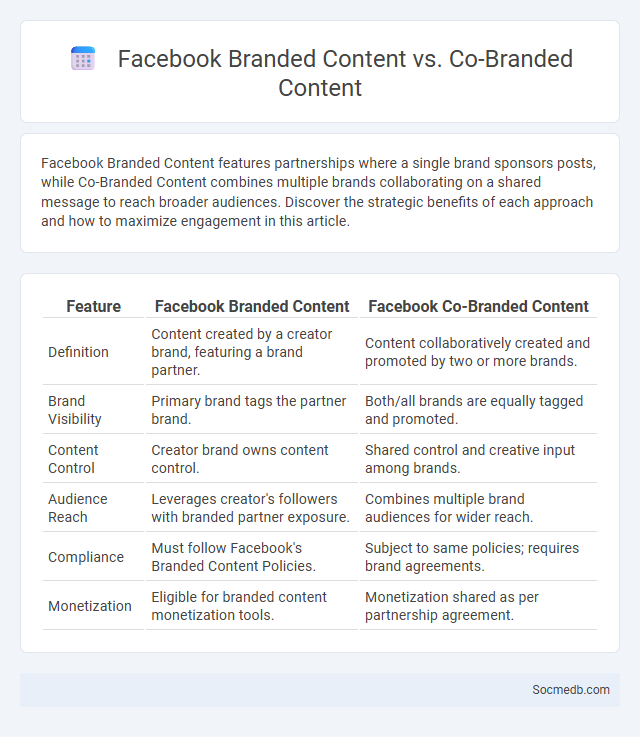
Photo illustration: Facebook Branded Content vs Co-Branded Content
Facebook Branded Content features partnerships where a single brand sponsors posts, while Co-Branded Content combines multiple brands collaborating on a shared message to reach broader audiences. Discover the strategic benefits of each approach and how to maximize engagement in this article.
Table of Comparison
| Feature | Facebook Branded Content | Facebook Co-Branded Content |
|---|---|---|
| Definition | Content created by a creator brand, featuring a brand partner. | Content collaboratively created and promoted by two or more brands. |
| Brand Visibility | Primary brand tags the partner brand. | Both/all brands are equally tagged and promoted. |
| Content Control | Creator brand owns content control. | Shared control and creative input among brands. |
| Audience Reach | Leverages creator's followers with branded partner exposure. | Combines multiple brand audiences for wider reach. |
| Compliance | Must follow Facebook's Branded Content Policies. | Subject to same policies; requires brand agreements. |
| Monetization | Eligible for branded content monetization tools. | Monetization shared as per partnership agreement. |
Understanding Branded Content: Definition and Purpose
Branded content refers to marketing materials that blend storytelling with a brand's identity to engage and resonate with the target audience. Its primary purpose is to create meaningful connections by delivering value and fostering brand loyalty without overtly pushing sales. Understanding how branded content influences your social media strategy can enhance your engagement and build lasting brand awareness.
What Is Facebook Branded Content?
Facebook Branded Content is a feature allowing creators and businesses to share sponsored posts that clearly disclose paid partnerships. Your branded content appears in the news feed with a "Paid Partnership" label, enhancing transparency between you, your audience, and brands. This tool helps build trust while maximizing reach and engagement through authentic collaboration on Facebook.
Defining Co-Branded Content in Digital Marketing
Co-branded content in digital marketing involves collaboration between two or more brands to create shared media that leverages each entity's audience and strengths for mutual benefit. This strategy amplifies reach, enhances brand credibility, and fosters deeper engagement by combining unique value propositions tailored to your target market. Effective co-branded content integrates both brands' identities seamlessly to deliver compelling, relevant messages that resonate with your social media followers.
Key Differences: Facebook Branded vs. Co-Branded Content
Facebook branded content features posts directly created and published by your brand's official page, showcasing your products or services with full control over messaging and audience targeting. Co-branded content involves collaboration between your brand and another entity, blending both brand identities in shared promotions that expand reach and enhance credibility. Understanding these key differences helps you choose the right strategy to maximize engagement and drive conversions on Facebook.
Benefits of Facebook Branded Content for Brands
Facebook Branded Content offers brands unparalleled opportunities to reach targeted audiences through authentic influencer partnerships, boosting engagement and brand trust. You can leverage Facebook's advanced analytics to measure campaign performance and optimize content strategy for higher ROI. This platform enhances brand visibility by seamlessly integrating promotional messages within users' native feeds, driving meaningful connections and conversions.
Advantages of Co-Branded Content Collaborations
Co-branded content collaborations on social media enhance brand visibility by combining the audiences of two or more entities, leading to increased reach and engagement. Such partnerships leverage the unique strengths and credibility of each brand, fostering trust and a higher conversion rate among target demographics. These collaborations also optimize marketing budgets by sharing costs while creating innovative, compelling content that resonates deeply with diverse consumer segments.
Content Creation: Guidelines and Best Practices
Effective content creation on social media involves understanding platform-specific algorithms to maximize reach and engagement. Incorporating high-quality visuals, concise captions, and relevant hashtags enhances visibility and fosters audience interaction. Consistent posting schedules combined with audience analysis help refine content strategies for sustained growth and brand authority.
Measurement and Performance: Analyzing Results
Measuring social media performance involves tracking key metrics such as engagement rate, click-through rate, and conversion rates to understand your content's effectiveness. Analyzing these results helps optimize strategies by identifying which campaigns resonate with Your audience and drive desired actions. Leveraging data analytics tools can provide deeper insights for continuous improvement and maximizing ROI on social media efforts.
Compliance and Disclosure: Navigating Facebook Policies
Facebook's compliance and disclosure policies require you to accurately represent your identity and clearly disclose sponsored content to maintain transparency and trust. Adhering to Facebook's Advertising Policies ensures your content meets guidelines related to prohibited content, targeting, and data use. Staying compliant helps protect your account from penalties and enhances your brand's credibility in the social media ecosystem.
Choosing the Right Approach: Which Content Strategy Works for You?
Choosing the right social media content strategy involves understanding your audience's preferences, engagement patterns, and platform algorithms to maximize reach and impact. Tailoring your posts with a mix of informative, entertaining, and interactive content increases your chances of building a loyal following and driving meaningful interactions. Analyzing performance metrics regularly ensures your strategy remains aligned with your goals and your audience's evolving interests.
 socmedb.com
socmedb.com